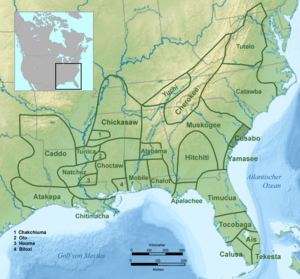Kiawah people facts for kids
The Kiawah were a group of indigenous peoples who lived in the coastal area of what is now South Carolina. They were part of the Cusabo people, a group of Native American tribes who lived in the lowlands near present-day Charleston, South Carolina. When English settlers first arrived and built their homes along the Ashley River, the Kiawah people who lived nearby were friendly towards them.
The Kiawah and the Etiwan tribe were two main Cusabo groups living close to the Charleston Harbor. While some other tribes in South Carolina's lowlands were not always linked to the Cusabo, the Kiawah were always considered part of the Cusabo alliance. An agreement from 1707 is the first clear record mentioning the Kiawah as part of the Cusabo. However, by 1682, the number of Kiawah people had dropped to about 160 due to diseases and wars. Today, the remaining Kiawah people are known as the Guaymari Kiawah.
Contents
Where the Kiawah Lived
The Kiawah people lived near the Ashley River from 1598 to 1682. After that, they moved to Kiawah Island and lived there from 1682 to 1695. At one point, the Kiawah asked for land for a special area south of the Combahee River, but the exact location of this land is not known today.
How the Kiawah Spoke
In the early 1600s, a Spanish explorer used a person from Santa Elena who spoke Spanish to help translate the Kiawah language. The Kiawah, along with other Cusabo tribes, lived across a wide lowland area. It is thought that these Cusabo tribes spoke similar, or even the same, language, which is generally called the Cusaboan language.
A linguist named Blair A. Rudes suggested that the "-bo" ending in names like "Cusabo" and "Kiawah" might be linked to Arawakan languages. However, there is no strong proof yet to confirm this language connection.
Meeting New Settlers
French settlers tried to build homes in the area in 1562, and the Spanish began their attempts in 1566. After being forced out in 1576, the Spanish returned. They burned many of the villages belonging to the Cusabo and Guale tribes. In 1598, the Kiawah and Escamacu tribes raided the Guale. Later, during the Yamasee War, the Kiawah fought alongside the English against other tribes like the Yamasee, Creek, Cherokee, and Catawba. These tribes were seeking revenge for unfair treatment by traders.
Kiawah Leaders and English Settlers
The leader of the Kiawah tribe was called the Cassique. The Cassique worked with the English settlers to create better trade, keep the peace, and form an alliance for protection.
Robert Sandford, an English settler, wrote in 1666 that the Kiawah Cassique warmly welcomed him. The Cassique promised Sandford a good welcome, plenty of food, and opportunities for trade. It is believed that the Cassique's pride in his land encouraged the English to build their settlement there.
Another English settler, Nicolas Carteret, wrote about his journey from Bermuda to the Ashley River. He visited the Port Royal area (near Charleston Harbor) because a settlement had been built there in April 1670. A Kiawah native, also called Cassique, helped Carteret on his travels. Carteret described him as "a very ingenious Indian, and a great linguist."
Kiawah Population Changes
By 1682, which is when the first census was taken, the Kiawah tribe had only about 40 bowmen (warriors). The total Cusabo population at that time was estimated to be around 664 people. By the time of the 1715 census, the total Cusabo population (not including the Etiwan) was 535 people. This included 95 men and 200 children. This big drop in population was caused by diseases like smallpox, as well as attacks from the Spanish and their Native American allies who were friends with the French.
Today, Kiawah Island, South Carolina is named after the Kiawah people.


